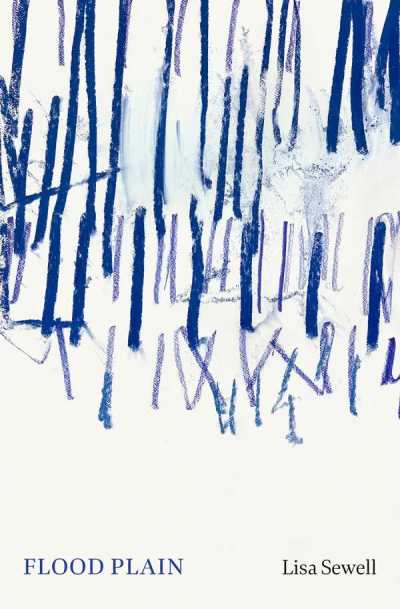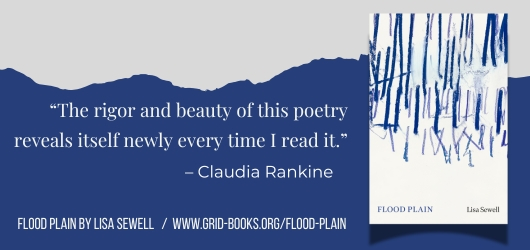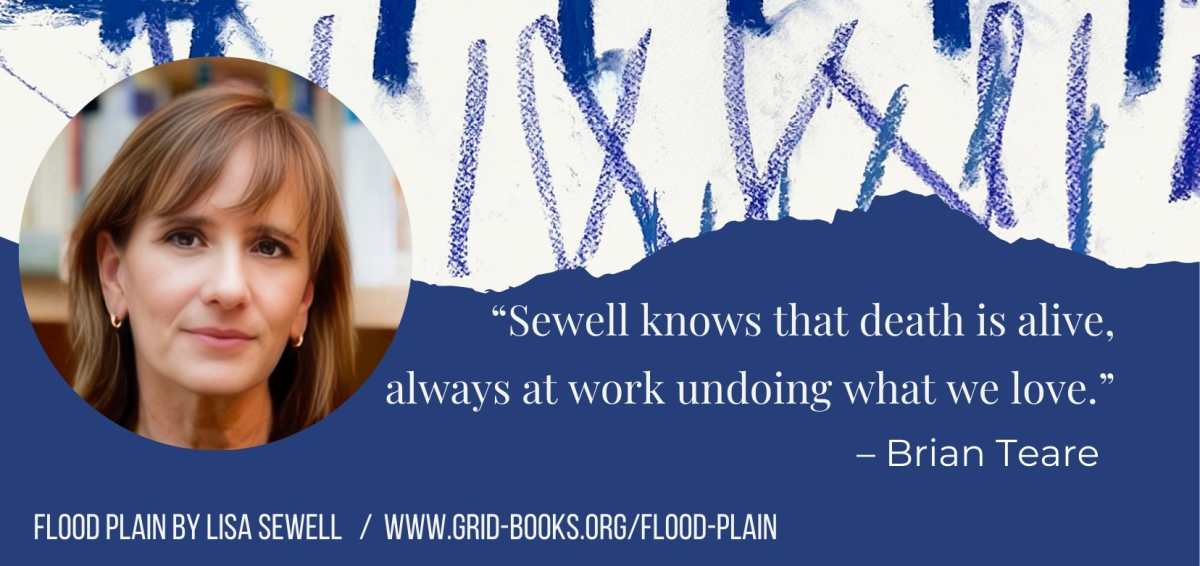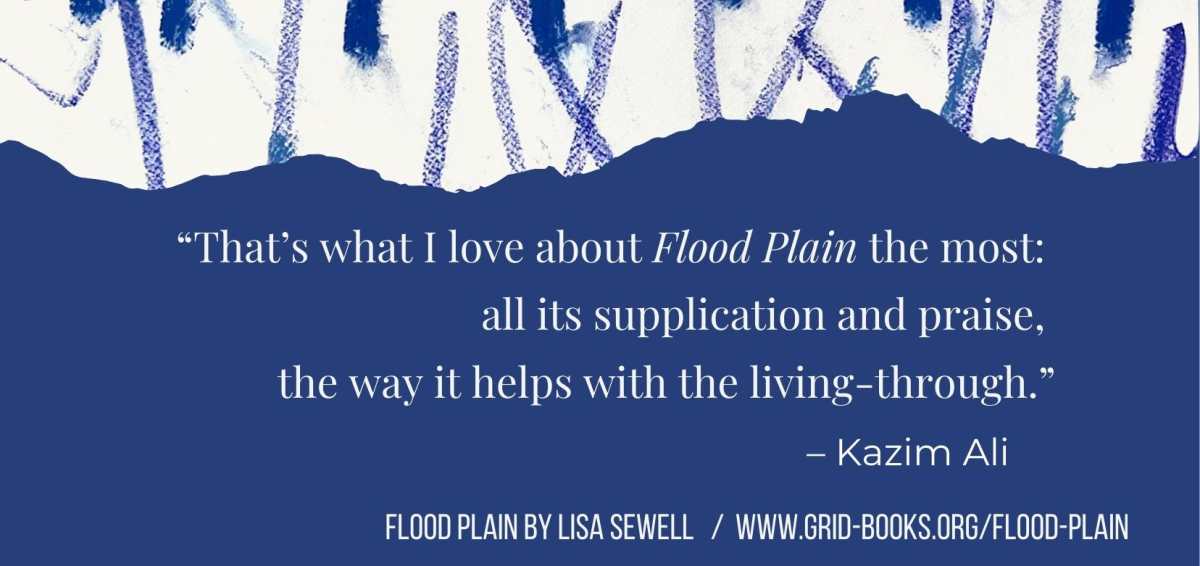Acts of Empathy: Writing with Animals

Reviewer Luke Sutherland Interviews Lisa Sewell, Author of Flood Plain
No, she can’t fly or walk through walls but there’s little doubt Lisa Sewell calls upon otherworldly powers in her ability to summon rhythm, sound, and physical expressions of being in her poetry.
In today’s interview, Lisa describes learning to “pay attention to the bodies in the world around me, from dirt, plants, and trees to the buzzy bees and the coyotes yipping in the night,” which helps explain why her work feels so resonant and tangible. Words, under her spell, seem to exist in a different state.
The author of five collections—including Flood Plain, which earned an enthusiastic review from Luke Sutherland in a recent issue of Foreword Reviews—Lisa has held residencies at Yaddo, MacDowell, Fundacion Valparaiso (Spain), the Sitka Center for Art and Ecology, and the Virginia Center for the Creative Arts. After a thirty year teaching career, she will retire this spring—and begin the next stage in her artistic journey, joining an expeditionary residency in the High Arctic aboard a tall ship.
We were thrilled when Lisa agreed to take a few questions from Luke.
Like the title of your new collection would suggest, water takes center stage as a unifying metaphor in Flood Plain. In what ways does water act as a companion to you, both in your personal life and in your work?
Water has also taken center stage in my life, though I’ve never really articulated it before. I didn’t intentionally make it a unifying metaphor in Flood Plain—but I guess it just happened. I grew up in Southern California and during the summer, spent as much time in and near water as I could, in the pool in our backyard in North Hollywood, at the beach body surfing and getting tossed by the strong waves of the Pacific. In college, I majored in genetics and marine biology and learned to scuba dive as part of my studies. It was one of the most significant experiences of my life. I loved being able to immerse myself in the world under the ocean, to exist in a new element. One of the things that got me writing the poems in Flood Plain about species extinction and biodiversity loss was learning about the decimation of the sea otter population on the west coast and realizing that if I went diving there today, I wouldn’t see any sea otters, the kelp bed forests would be sparse and empty. It was shocking to realize that this decline had taken place during my lifetime.
I learned to white water kayak about 25 years ago and now rivers are my companions as well. I love being on the water, paddling around rocks and through rapids, watching a family of mallards or mergansers, which are regulars on the rivers of Pennsylvania where I have spent most of my river time, paddle upstream. Kayaking has been another major conduit for me to connect with and immerse myself in the more-than-human-world.
The poem “Dry Spell,” an ars poetica, spells out your approach to writing beautifully, like in the line: “I took my form and meter from other animals and the natural world, / which abounds in forms.” Can you talk about the genesis of this poem?
“Dry Spell” is based on notes I took when I studied with Galway Kinnell at New York University. In the “Craft of Poetry,” each week he focused on a different element of craft from voice to rhythm to image and figurative language. I’d been a science major as an undergraduate and didn’t know much about poetry when I came to NYU’s MFA program, so I was like a sponge, absorbing everything and writing it all down. I took fastidious notes and when I returned to my notebooks a few years ago, at a point when I’d been going through a dry spell of sorts, I had forgotten how much emphasis Galway put on the ways poetry and song are indebted to natural processes and cycles in the more-than-human world. You can see it in his poems but somehow, I had forgotten.
Reading through my notes made me excited about poetry again. I saw how much I had learned from that class about paying attention to the bodies in the world around me, from dirt, plants, and trees to the buzzy bees and the coyotes yipping in the night. And I recognized how much my own current practice is influenced by the things that those other beings can teach us. The most memorable class was when Galway brought in a tape of different animal calls, from the wood thrush and timber wolf to the humpback’s songs and talked about how the oral tradition of poetry draws on these essential expressions of being. I wrote the poem as a kind of prayer and to express gratitude to a teacher whose words came back to me many years later and showed me a path or ideal to aspire to.
In many of these poems, the speaker bears witness—to the deteriorating health of a loved one, the dehumanizing effects of prisons, to women artists, and drone strikes, but especially to ecological collapse. To what extent do you see yourself working in the tradition of the nature poem today and as part of a lineage of environmental writing?
Over the years my poems have shifted from looking inward toward my own experiences and struggles to trying to turn outward toward the world. My third book, Impossible Object, juxtaposed poems about personal loss with the horrors of state-sanctioned executions and endless wars in Iraq and Afghanistan, and at that time, I started thinking just a bit about extinction and natural and unnatural disasters like the tsunami in Japan and hurricanes in the US. With Flood Plain, my work has expanded even further to focus on our endangered planet in poems that observe and try to learn from wild and un-wild beings. I started working on the poems for this book around 2019 when I became despondent and immobilized by what was happening in this country and the larger world.
At the same time, I started teaching courses on environmental theory, ecopoetics, and literature and the environment. I became interested in how contemporary writers around the world are responding to climate change, rising temperatures, extreme weather events, and the lack of action on the part of the US, which is responsible for around 15 percent of the world’s carbon emissions. Because of conversations I was having with my students and friends, it became impossible for me to keep the dread, fear, and grief about the dying planet out of my poems. I was looking for alternatives to the Romantic tradition that treated the natural world as other and separate, or as a source of solace. I connected with thinkers like Anna Tsing, Donna Haraway, and Stacy Alaimo, as well as Robin Wall Kimmerer, ethnobotanists and ecofeminists who emphasize multi-species systems and the interconnections and interdependencies between bodies and all living beings, as well as reciprocity and gift economies as an alternative to neoliberalism.
In his short introduction to Red Start: An Ecological Poetics, Forest Gander suggests that what differentiates ecopoetry from traditional nature poetry is an emphasis on relationality and interdependencies: “the relationship between nature and culture, language and perception,” and the desire to “acknowledge the economy of interrelationship between human and non-human realms.” That is the tradition I am trying to write my way into with Flood Plain. In my classes, I feel like I am helping to raise my students’ awareness about climate change through the books I teach. Flood Plain is my own attempt to contribute to those voices sounding the alarm.
As much as this collection is about witness, it’s also about memory, particularly that of animals. Creatures in these poems hold memories in their bones, of past extinctions, of their own species’ struggles. What draws you to the perspective of animals, and how does that point of view impact your craft? What inspired you to start writing about animals and what role do they play in the book?
Years ago, I went to an exhibition by Philadelphia artist, Susan Hagen, called Animalia Rarissima. The show consisted of a series of small carved and painted wood sculptures of animals selected from the Department of Endangered Species (US Fish and Wildlife Service) list of 1,072 animals. Writing about the work, Hagen explains that the sculptures “celebrate the beauty of animals but also, like Nancy Grave’s sculptures of camels and Walton Ford’s paintings of extinct birds, examine the role that these diminished species have in a contemporary human world that is divorced from direct daily interaction with wildlife and the natural world.” Her series included the grizzly bear, the humpback whale, the whooping crane, the orangutan, the green sea turtle, and many others. The sculptures were all on plinths and displayed in a way that honored and mourned them, grieving but also monumentalizing their existence, emphasizing their peril. Each animal stood or swam alone on its plinth isolated from others of its kind and from its fellow creatures, captured, in a way by the artist’s eye and hand but also calling attention to their plight.
This show haunted me. I couldn’t stop thinking of the elaborately carved fur of the grizzly, standing on its hind legs and ready to strike, or the sea turtle with its green-tinged scutes, fore and hind legs stilled in their motion. The poems I wrote in response to Susan’s sculptures were the true starting point for Flood Plain. I started writing a series of poems that tried to honor these creatures I would never meet because of human activities, my own included. I researched their physiology and life histories, as well as the roles they played in various mythologies, from Greek and Chinese to Creek and Paiute. I wanted to meditate on the details of each endangered animal’s existence, including their elimination, and also inscribe a connection to these disappearing beings, to blur the boundaries between my body and their bodies, to emphasize our interdependencies but also my own complicity in their demise.
In “Field Notes on the Toroweap Formation,” the speaker of the poem retraces the surveying path of 19th-century American geologist John Welsey Powell along the Colorado River. In naming and defining the features he encountered, Powell, an agent of a colonizing empire, was “erasing everything that was there / with his imagination.” Can you talk about how you approached writing about natural landscapes in light of these observations?
As I tried to outline above, one of the things I was trying to do with this book is think about an ethical position from which to write about the more-than-human world and about the experience of being in wild, or at least ostensibly wild places. I am mindful of the idea that there is nothing in the natural world that is unaffected by human activity and anthropogenic climate change. I don’t know if it’s possible, but I wanted to engage with and write about places like the Grand Canyon or the coast of Oregon without laying claim to them through language. Influenced by my reading in environmental theory and also ecopoetry, I wanted to find ways to give some sense of the intelligence and agency of the rivers or the trees, the birds and other critters I encountered.
Flood Plain includes a series of poems about the demise and diminishment of the Colorado River, including “Field Notes,” that are based on my research but also my first-hand experience from two sixteen-day river trips. John Welsey Powell was named the first head of the Bureau of Land Management and was something of a conservationist, but his expeditions on the Colorado were about conquest. He gave names to some of the rock and river formations he encountered as if he were writing on empty space, as if no one else had slept on the beaches or admired the natural springs and rock formations. While he drew on the help and advice of Paiute people, Powell does not acknowledge the existence of ancient Anasazi tribes who lived in the canyon long before he and his team arrived, and I wanted to write about that contradiction, and about my own discomfort with reproducing that settler colonialist project in the trips I took.
It was hard to figure out how to write about the magic of the place—from the river rapids to the side canyons—but also acknowledge that there is nothing wild about that river anymore. The water flows from the bottom of the Glen Canyon dam and is clear green and freezing cold, when it should be silty brown and warm—especially in June, which is when I was on the river. The huge sandy beaches have been washed away by daily tides, and the flora and fauna have completely changed. Invasive plant species dominate. But there I was benefitting from Powell’s efforts and supporting the multi-million-dollar whitewater tourist industry. I felt ambivalent and critical but also lucky and I tried to write into that contradiction.
At the same time, it was astonishing to read Powell’s journals and think about what it would have been like to approach the steep drops and huge wave trains blind. I had some compassion for him and felt connected to his human struggles and the tremendous losses he suffered on the trip. But I also wanted to call him out for fostering an acquisitive, manifest destiny approach.
What’s on the horizon for you, as a writer, teacher, and person?
I am about to retire after nearly thirty years of university teaching and will be happy to start writing full time. I have been lucky enough to teach at a state maximum security prison as part of my job and I hope to continue to do that kind of work. I am currently working on a series of lyric essays about my family, focusing mostly on my relationship with my father, an immigrant from eastern Europe, who lived to be 103 and was much older than my mother and old enough to be my grandfather. This summer, I hope to begin working on a new book of poems, further developing my dedication to tracing my entanglements with thriving and endangered species and ecosystems.
I am going on an amazing trip in May. I’ll be joining an expeditionary residency called “The Arctic Circle,” which voyages into the High Arctic aboard a traditionally rigged, 150-foot tall ship. Along with about twenty other artists from around the world, I’ll be working on my writing and helping to sail the ship through parts of the Norwegian Arctic. It’s a once-in-a-lifetime opportunity to see the ice and the glaciers before they disappear completely. I’m looking forward to collaborating with and learning from other like-minded creative thinkers and makers, and to following my own imagination into this remote corner of the world, which of course is also the ground zero of climate change.
Flood Plain
Lisa Sewell
Grid Books (Jan 21, 2025)
In grief-soaked language, Lisa Sewell’s poetry collection Flood Plain meditates on the parallels of personal, ecological, and social loss, aching for the world with “a gust of triumph beneath / the syntax of regret.”

Open couplets are the main structuring element, with paired lines mirroring the thematic twining of nature and society. Scientific jargon curls up to poetic diction with ease—susurrations and passerines, skimshanders and colitis coexist in this collection. “Dry Spell,” an ars poetica, makes explicit the origin of Sewell’s approach: “I took my form and meter from other animals and the natural world, / which abounds in forms.”
Animals inhabit the lines not only as structural inspiration, but as subjects. Multiple poems are odes to specific species, connected by the thread of memory. These animals, the poems suggest, remember extinction in their bones. The speaker often plays the role of witness, rendering observations with the patience of a naturalist, but this witnessing also extends beyond the natural world.
Cognitive bridges are drawn between ecosystem degradation and other specters of modernity, like settler colonialism and the American prison system. Through juxtaposition and metaphor, these links are shown not to be incidental, but inherent. In “At Glen Canyon National Recreation Area,” dams are built over Indigenous land and crinoid fossils alike, devastating the land both culturally and ecologically. “Chelonia mydas (green sea turtle)” notes Columbus’s encounter with the Caribbean turtles, their numbers so vast that “they covered the sea, closing the gap / between ship and sand, as though // you could stroll across their backs to conquest.”
In this manner, the poems of Flood Plain draw a map of the interconnectedness of all, distilled in a rumination on the extinct golden toad: “Because his screech is melody / and we are all in jeopardy // and all have golden toad songs / semaphoring in our throats.”
Reviewed by Luke Sutherland
January / February 2025
Luke Sutherland



